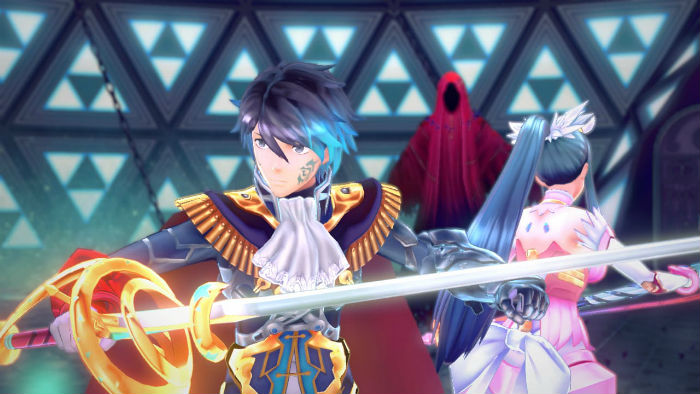
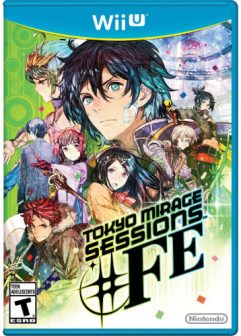 Unconventional crossover doesn’t miss a beat
Unconventional crossover doesn’t miss a beat
Nintendo and Atlus’ Tokyo Mirage Sessions #FE is the role-playing game Wii U owners have been waiting for. This dream crossover title mashes together two fan-favourite Japanese RPG franchises—Nintendo’s Fire Emblem and Atlus’ Shin Megami Tensei—in an epic, all-new RPG adventure that is easily one of the best from this entire console generation. On Atlus’ side, inspiration comes principally from their SMT spin-off series Persona, and that is definitely worth getting excited about. All the hallmarks of this beloved series are here in spades, including a modern-day Tokyo setting, a teenage cast overflowing with personality, surreal dungeons that explore the human psyche, shadowy otherworldly invaders, and amped-up style to the nines. Persona summons also weave their way into the narrative and the classical turn-based battles, albeit with an interesting Fire Emblem twist.
Tokyo Mirage Sessions‘ story revolves around Japan’s entertainment industry and booming idol culture, giving us a peek behind the glitz and glamour to explore the stiff demands and immense pressure that goes along with it. The idol phenomenon is huge in Eastern Asian, Japan in particular, so while the topic may not resonate as strongly with Western audiences (though of course many otaku folks here are obsessed with it, too), it’s certainly an under-used and intriguing industry to base a video game on.
Atlus deserves credit for going all-in on this central theme, unabashedly weaving it into every single aspect of the game, from the presentation and gameplay, all the way down to the specific wording used. At Tokyo Mirage Sessions’ title screen you don’t “Start” the game, you “Debut”. Instead of checking your “Equipment” and character “Status” you peruse your “Wardrobe” and “Artists”. During turn-based battles you’re surrounded by a roaring audience who will cheer you on and award you items for putting on a solid performance. Rarely before have I seen a subject matter integrated top to bottom this well in an RPG, and it works wonders to immerse you into the overall experience.
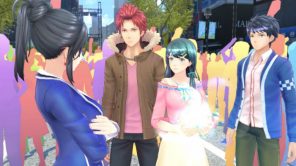 Game Details
Game Details
Platform: Wii U
Developer: Atlus
Publisher: Nintendo
Genre: Role-playing
Modes: Single-player
ESRB Rating: T (Teen, 13+)
Become a Mirage Master
The game starts off in present day Tokyo and follows a group of teenage idol newcomers who wind up narrowly surviving an attack by sinister spirits known as Mirages, only to find themselves thrust into a dangerous cross-dimensional battle against them. These malevolent Mirage creatures, driven by their insatiable desire to suck the creative energy from idols (who ooze creativity, naturally), and all their adoring fans, start opening portal gateways between their realm and Earth causing all kinds of chaos. Fortunately, our idols soon discover their latent ability to connect with benevolent Mirages, who just so happen to be spirit forms of some of the greatest heroes from the Fire Emblem series, to become powerful Mirage Masters.
 To help draw out their Mirage Master powers, the group joins the Fortuna Entertainment talent agency, led by former idol Maiko Shimazaki, who uses her base of operations as a secret recruitment hub for Mirage Masters. In order to bolster their abilities, the team must learn to channel their inner performer and become the best pop idols they can be. Assisting our idols every (dance) step of the way are iconic characters from Fire Emblem Awakening (Chrom, Virion, and Tharja) and Fire Emblem: Shadow Dragon (Caeda, Cain, Draug, and Navarre), as well as a younger Tiki who is represented in the real-world as a virtual “Uta-loid” à la Hatsune Miku. These characters have all gone through stylish new redesigns with a distinct supernatural flair, but fret not Fire Emblem faithful—their visual essence remains artfully preserved and their personalities are all remarkably true to form.
To help draw out their Mirage Master powers, the group joins the Fortuna Entertainment talent agency, led by former idol Maiko Shimazaki, who uses her base of operations as a secret recruitment hub for Mirage Masters. In order to bolster their abilities, the team must learn to channel their inner performer and become the best pop idols they can be. Assisting our idols every (dance) step of the way are iconic characters from Fire Emblem Awakening (Chrom, Virion, and Tharja) and Fire Emblem: Shadow Dragon (Caeda, Cain, Draug, and Navarre), as well as a younger Tiki who is represented in the real-world as a virtual “Uta-loid” à la Hatsune Miku. These characters have all gone through stylish new redesigns with a distinct supernatural flair, but fret not Fire Emblem faithful—their visual essence remains artfully preserved and their personalities are all remarkably true to form.
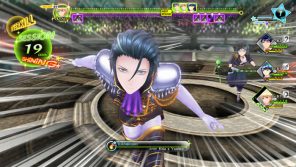 Dazzling presentation
Dazzling presentation
From start to finish, Tokyo Mirage Sessions is an absolute audio/visual delight. Characters are beautifully designed and very well animated, especially in the lively, recurring anime scenes that really bring this story to life. To keep in the spirit of the game’s focus on Japan and its idol culture, all voice acting during cutscenes is in Japanese, subtitled in English. Some people may chalk this up as laziness on the part of Atlus and Nintendo, but for me, I wasn’t bothered by the absence of an English dub since I always flick on Japanese voice tracks when given the chance anyway. The Japanese audio also extends to incredibly catchy original songs by Japanese entertainment giant Avex, with one of my favourites being Reincarnation from Japanese voice actress Yoshino Nanjo. As far as the quality of the voice acting goes, characters each have a distinctive voice, are quite expressive, and possess charming mannerisms, so I was quite enamored with the dialogue too.
The main hub districts of Tokyo you visit, like Shibuya and Harajuku, are quite pleasing to look at as well, each having their architecture and layouts based loosely on reality with a touch of Persona vibrancy thrown into the mix. It’s the dungeons though, which are located in the Mirages realm known as the Idolasphere, where the game gets very interesting. These surreal areas are like corrupt, nightmarish versions of well-known Japanese entertainment industry landmarks, such as Shibuya’s flagship 109 department store, and metaphorically explore different elements of idol culture. For example, in this particular Shibuya dungeon you travel between floors by crawling through the sleeves of huge, lifeless costumes, hinting at how hollow and superficial the fashion industry can be. In a later dungeon, your idol squad will need to avoid cameras that warp you back to the beginning, perhaps symbolizing the relentless spotlight idols exist in, and their secret desire to at least sometimes step away from the limelight. Like virtually every other aspect of Tokyo Mirage Sessions, dungeons play in perfect to the game’s central motif and offer a fascinating glimpse at the sometimes overlooked darker side of idol culture.
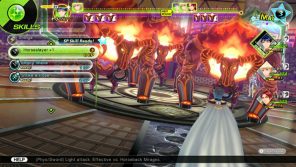 Stylish Gameplay
Stylish Gameplay
All this beautiful audio and pristine graphics would mean diddly-squat without quality gameplay to back it up, but here too the game absolutely shines. The turn-based battle system relies heavily upon the classic Fire Emblem rock-paper-scissors weapon triangle involving swords, lances, and bows, while also throwing in elemental powers such as fire, ice, and thunder into the mix. By exploiting an enemy’s weakness and having the right skills equipped, your three-person team can trigger devastating Session Attacks where everyone jumps into the fray for a single powerful strike. Weapons all possess base affinity stats (either weak, neutral, or resistant to other weapons and elements), so having the right equipment to trigger Session Attacks, and defend from enemy attacks, is paramount to success in battle. Perhaps one of the coolest aspects is that your enemies can also trigger Session Attacks if they exploit your weakness, which can result in punishing damage and further emphasizes to need to head into dungeons fully prepared.
Numerous other attack types weave their way into battle over time, including Duo Attacks performed by your Fire Emblem Mirage partner that usually result in a mesmerizing display of action, lights and colours, as well as special Performance Attacks that you can initiate after earning SP naturally during battle. Later, you’ll acquire the ability to launch elaborate Ad-Lib Performances, which are triggered by meeting certain conditions in battle, and again here these attacks play brilliantly into the game’s pop star theme. I also loved the truly stunning battle graphics that attempt to emulate the flashy, showy, high energy feeling you’d experience at a real pop idol concert. You’re even surrounded by adorning fans who watch the action gladiator arena style, further emphasizing the fact that battles are essentially live concert performances in disguise.
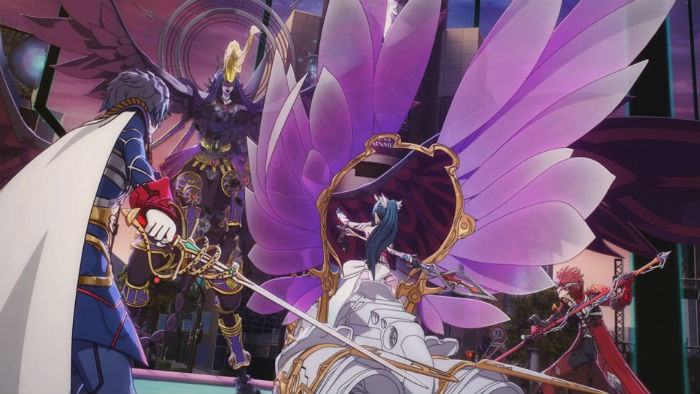
Final Thoughts
With Nintendo’s next console, NX, expected to arrive in March 2017, Tokyo Mirage Sessions #FE may very well be Wii U’s final RPG swan song. It is everything you’d want in a traditional, turn-based RPG: an amazing presentation, backed up by an engrossing story and fun, highly strategic gameplay. Whether you’re a Shin Megami Tensei, Fire Emblem, or RPG fan, don’t pass up your chance to play one of the best games in the genre to come along in years. The only real complaint I have with the game is the sometimes long load times, but it’s a minor quibble in an otherwise outstanding RPG.
+ Exceptional integration of the game’s central idol theme
+ Truly outstanding presentation, one of the best looking RPGs ever
+ Endearing characters and a fun story
+ Highly strategic & entertaining battle system
+ Intriguing, thought-provoking puzzles
+ A+ soundtrack
– Lengthy load times
SCORE
Gameplay: 4.5/5
Graphics: 5/5
Sound: 5/5
Lasting Appeal/Replayability: 4.5/5
Overall Rating 4.75/5 (95%)



